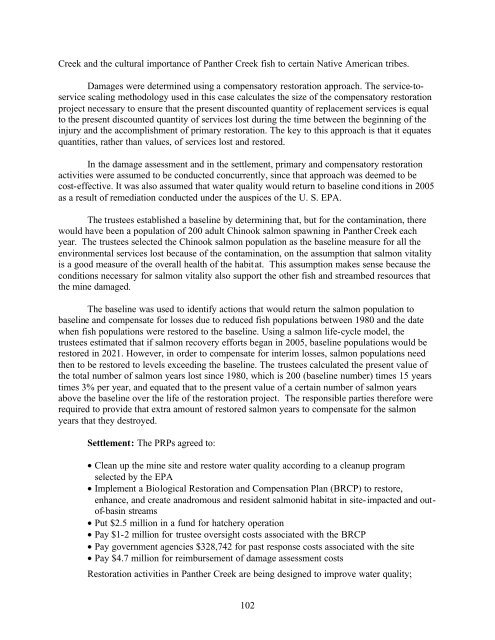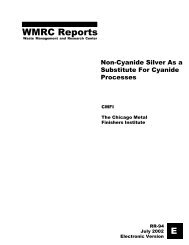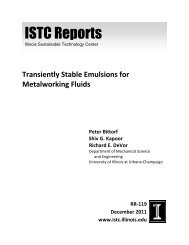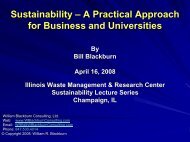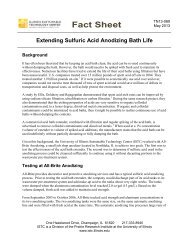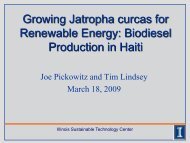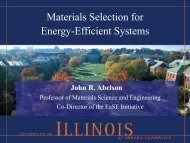Natural Resource Damage Assessment: Methods and Cases
Natural Resource Damage Assessment: Methods and Cases
Natural Resource Damage Assessment: Methods and Cases
You also want an ePaper? Increase the reach of your titles
YUMPU automatically turns print PDFs into web optimized ePapers that Google loves.
Creek <strong>and</strong> the cultural importance of Panther Creek fish to certain Native American tribes.<br />
<strong>Damage</strong>s were determined using a compensatory restoration approach. The service-toservice<br />
scaling methodology used in this case calculates the size of the compensatory restoration<br />
project necessary to ensure that the present discounted quantity of replacement services is equal<br />
to the present discounted quantity of services lost during the time between the beginning of the<br />
injury <strong>and</strong> the accomplishment of primary restoration. The key to this approach is that it equates<br />
quantities, rather than values, of services lost <strong>and</strong> restored.<br />
In the damage assessment <strong>and</strong> in the settlement, primary <strong>and</strong> compensatory restoration<br />
activities were assumed to be conducted concurrently, since that approach was deemed to be<br />
cost-effective. It was also assumed that water quality would return to baseline conditions in 2005<br />
as a result of remediation conducted under the auspices of the U. S. EPA.<br />
The trustees established a baseline by determining that, but for the contamination, there<br />
would have been a population of 200 adult Chinook salmon spawning in Panther Creek each<br />
year. The trustees selected the Chinook salmon population as the baseline measure for all the<br />
environmental services lost because of the contamination, on the assumption that salmon vitality<br />
is a good measure of the overall health of the habitat. This assumption makes sense because the<br />
conditions necessary for salmon vitality also support the other fish <strong>and</strong> streambed resources that<br />
the mine damaged.<br />
The baseline was used to identify actions that would return the salmon population to<br />
baseline <strong>and</strong> compensate for losses due to reduced fish populations between 1980 <strong>and</strong> the date<br />
when fish populations were restored to the baseline. Using a salmon life-cycle model, the<br />
trustees estimated that if salmon recovery efforts began in 2005, baseline populations would be<br />
restored in 2021. However, in order to compensate for interim losses, salmon populations need<br />
then to be restored to levels exceeding the baseline. The trustees calculated the present value of<br />
the total number of salmon years lost since 1980, which is 200 (baseline number) times 15 years<br />
times 3% per year, <strong>and</strong> equated that to the present value of a certain number of salmon years<br />
above the baseline over the life of the restoration project. The responsible parties therefore were<br />
required to provide that extra amount of restored salmon years to compensate for the salmon<br />
years that they destroyed.<br />
Settlement: The PRPs agreed to:<br />
• Clean up the mine site <strong>and</strong> restore water quality according to a cleanup program<br />
selected by the EPA<br />
• Implement a Biological Restoration <strong>and</strong> Compensation Plan (BRCP) to restore,<br />
enhance, <strong>and</strong> create anadromous <strong>and</strong> resident salmonid habitat in site-impacted <strong>and</strong> outof-basin<br />
streams<br />
• Put $2.5 million in a fund for hatchery operation<br />
• Pay $1-2 million for trustee oversight costs associated with the BRCP<br />
• Pay government agencies $328,742 for past response costs associated with the site<br />
• Pay $4.7 million for reimbursement of damage assessment costs<br />
Restoration activities in Panther Creek are being designed to improve water quality;<br />
102


